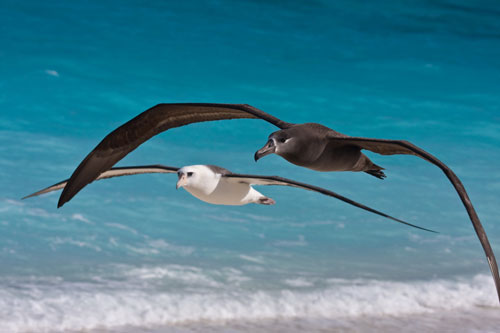In recent years more and more seabird studies, including those conducted on albatrosses and petrels, have included fixing external devices ('tags') to birds to follow them at sea and to obtain physiological and ecological data. Such devices include satellite or PTT (Platform Terminal Transmitter) trackers and GLS (Global Locating System or geolocator) data loggers (also called archival tags).
Sylvie Vandenabeele (Swansea Moving Animal Research Team, Swansea University, Wales, UK and colleagues writing in the journal Marine Biology have looked at the generally-accepted working rule that such devices should not weigh more than 3% of the host bird's mass. Their study shows that the additional mechanical power expended by a bird carrying a device increases linearly with device mass. However, both device mass and drag are important as devices used on flying birds are not perfectly streamlined.

Black-footed and Laysan Albatrosses fly together
Photograph by Eric Vanderwerf
The paper's abstract follows:
"Current guidelines for instrumenting birds state that external devices should not exceed 3-5% of the birds' body mass; however, the energetic consequences of carrying any given device mass are likely to vary according to the morphology and ecology of the species concerned. We used a freeware program to estimate the mechanical power requirements of flight at the minimum power speed for 80 species of flying seabird from 8 major groups with payloads of increasing mass. Devices representing 3% of the bird's body mass resulted in an increase in energy expenditure for flight ranging from 4.67 to 5.71% without accounting for the increase in body drag coefficient associated with external devices. This effect differed within and between seabird lineages with members of the Alcidae and Phalacrocoracidae experiencing the highest energetic costs of any increase in device mass. We propose that device effects on seabirds could be further reduced through consideration of species-specific effects of added payload and drag."
References:
Vandenabeele, S.P., Shepard, E.L., Grogan, A. & Wilson, R.P. 2012. When three per cent may not be three per cent; device-equipped seabirds experience variable flight constraints. Marine Biology 159: 1-14.
Vandenabeele, S.P., Wilson, R.P. & Grogan, A. 2011. Tags on seabirds: how seriously are instrument-induced behaviours considered? Animal Welfare 20: 559-571.
With thanks to Ian Jones and Rory Wilson for information.
John Cooper, ACAP Information Officer, 7 March 2012

 English
English  Français
Français  Español
Español